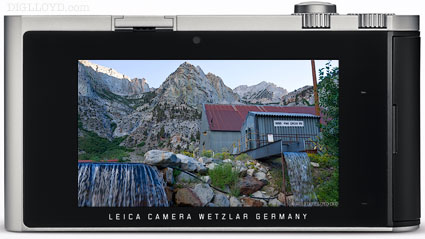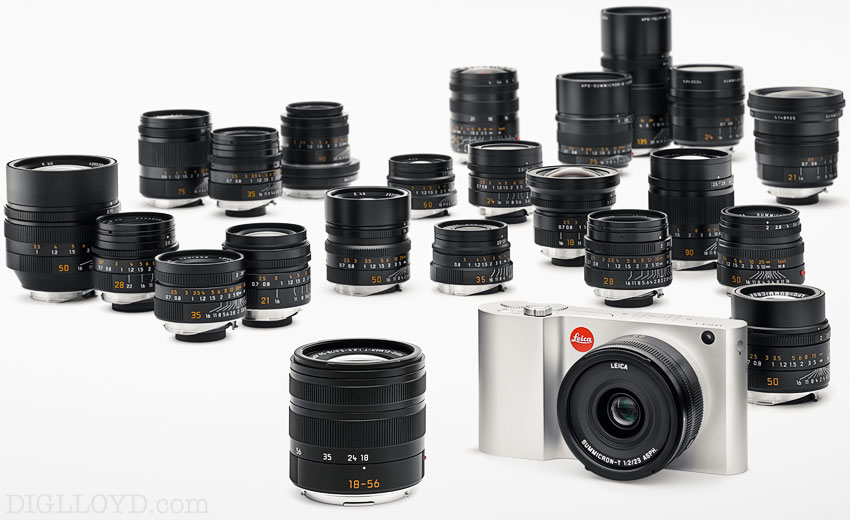Leica T System: Quick Comments
I’m unsure of reviewing the new Leica T (interest?); with native optics it would go into Guide to Mirrorless if reviewed, as did the Leica X2 and Leica X Vario.
Bottom line is that the Leica T will probably be snapped up by the target demographic in Leica stores; there is little doubt in my mind that it will sell very well and that it will fill a hole in the product line for Leica. It is after all, of beautiful construction and lines. Leica knows what drives their business and it is not my place to say they are wrong in that regard. Everyone gets to vote with their wallet, and that I applaud.
B&H Photo has the Leica T system available for preorder.

Comments
- Users worldwide are surely on tenterhooks while they await the “dynamic simplicity” with AUDI flair. But from what I see, the controls will frustrate for non-casual use; with few to no buttons, that means a lot of menu navigation (which I won’t be able to easily see in dim lighting due to presbyopia). Seemingly more jewelry than camera; elegant lines. Style is clearly the key goal, and seemingly achieved in the Leica T.
- With the camera body at $1850 and the lenses about the same, and the EVF at $595, this is a ~$4200+ system with one (1) lens, or ~$6000 with the prime and the zoom. See comments above on target demographic.
- Does the Leica T offer an electronic first curtain shutter, avoiding the bang-bang shutter vibration issues with telephoto lenses, as with the Leica M240 ?
- The press images show the T with the entire M lens line, and there is lens adapter support for M on T. This is the key feature that piques my interest as being a sort of modernized and shrunken Leica M8 with Live View, and Leica deserves some praise for making this effort. How well the M lenses perform on the Leica T sensor cannot be assumed, but Leica might have made some efforts with the sensor to deliver good quality.
- An optional 2.36M dot EVF for $595 extra is a big plus for aging eyes. Now if only that resolution can be supported on the Leica M Typ 240. But the contacts on the Leica T EVF appear to be completely incompatible.
- For shooting pictures, it’s hard to get excited about 16 megapixels in a system camera when Sony is on the full-frame warpath, already at 50% or 110% higher resolution than the Leica T. The Sony A7R has 36 megapixels on full frame with built-in EVF. The A7R is not so sexy in the status department, but wow, that’s a huge difference in imaging for less money.
- A 1/180 second flash sync with external optional flash is of very little practical use. What it means in practice is no flash fill or at best, slow-speed sync, and possibly sacrificing the EVF in order to mount the flash. Highly unpalatable on both counts. That one feature makes the Ricoh GR or Sony RX1R a vastly superior choice for outdoor shooting for people, or similar.
My advice for serious shooters: go straight to the Ricoh GR (about $649), which to this day puts all other APS-C cameras to shame for its outstanding design execution, lens performance, built-in full-sync flash, and overall feature set, lacking only one thing, an EVF. Less is more, but the GR is a case of “more is more and far more for far less”.
Alternately, the Sony A7 is 24MP full frame with built-in EVF, very compact and relatively inexpensive. Or the 36MP Sony A7R. These camera are going to have some very nice lenses arriving late this year; I just cannot see investing in APS-C at this point.
But all of that is sidesteps the target market goals: the Leica T is a strong fashion statement with elegant lines, and it should be understood in that context.

Leica press release
There is an apparent error: a 23mm lens on APS-C is equivalent to ~35mm on full frame (press release says 50mm).
Los Angeles, California - April 24th, 2014 -- Leica Camera continues to celebrate its journey into the future with the launch of the radically new yet brilliantly familiar Leica T-System. The Leica-T was designed with dynamic simplicity in collaboration with AUDI Design and it is the fourth system ever to be released from Leica. The Leica T-System features Wi-Fi, a rebuilt graphical user interface (GUI), Adobe® Photoshop® Lightroom®, a professional digital workflow solution for Apple Mac® OS X and Microsoft Windows®.
Leica has been praised for a century for its precise engineering while understanding the importance of design. As a result, Leica has created tools that are the perfect balance of purpose and emotion. At the heart of this praise is the collaboration with AUDI design and the creation of the Leica T-Unibody. The Unibody was painstakingly made by hand and machined from a single, solid block of aluminum, with a sleek and tactile finish. The new body is a natural extension of the user’s hand and photographic vision allowing complete focus on crafting the perfect image. Using the integrated Wi-Fi module these images can be wirelessly transmitted to smartphones, tablets, and various social media platforms via the new Leica-T app which is available for iOS devices. Leica customers can also download image processing software, Adobe® Photoshop® Lightroom®, free after registering their camera on the Leica website. The digital image processing software offers a comprehensive range of functions for the management, processing, and presentation of pictures and video.
Leica has also collaborated with AUDI Design to create new and unique accessories. These accessories include bags and cases available in yellow, orange-red, black and white. The bags, cases, and straps were designed using the new, innovative Easy-Click system. Easy-Click was designed to effortlessly connect the user’s straps to their bags and cases.
Two new lenses are being introduced that will accompany the Leica T-System launch: the Leica Vario-Elmar-T 18-56 mm f/3.5-5.6 ASPH and the Leica Summicron-T 23 mm f/2 ASPH. The Leica Vario-Elmar is ideal for creative innovators who want true versatility in their photography allowing them to seamlessly shoot landscapes, portraits, and other limitless forms of creative outlets. The Leica Summicron-T 23 mm f/2 ASPH which equates to the traditional reportage focal length of 50mm gives the user everything they need to capture all the decisive moments. The Leica M-Adapter T expands the lens selections to include all Leica M-Lenses produced after 1954.
The Leica T features a large high performance, APS-C-format CMOS image sensor with over 16.5 megapixels (effective 16.2 MP) that is the perfect combination of performance and image quality. The MyCamera menu can be customized to the user’s preferences allowing easier access to all their frequently used settings. The system also includes a high-resolution electronic viewfinder with an integrated GPS feature and tilt and swivel function allowing angles to be adjusted. The new Leica SF 26 flash unit gives users the ability for perfect flash exposures and fill light. Unique to the Leica SF 26 flash allows it to be used as an LED light source for recording video.
The Leica T-System will be available to order starting Monday, May 26th through Leica Stores, Leica Boutiques, and select Leica Dealers.

| Camera type: | Leica T (Typ 701) |
| Lens connection: | Leica T bayonet fitting with contact strip communication between lens and camera |
| Lens system: | Leica T lenses |
| Sensor: | CMOS APS-C 23.6 x 15.7 mm with 16.5/16.3 million pixels (total/effective), format aspect ratio 3:2 |
| Resolution: | 4944 x 3278 pixels JPEG: 4928 x 3264 (16 megapixels), 4272 x 2856 (12.2 megapixels), 3264 x 2160 (7 megapixels), 2144 x 1424 (3 megapixels), 1632 x 1080 (1.8 megapixel) |
| Picture data file formats / compression rates: Selectable: | JPG Superfine, JPG Fine, DNG+ JPG Superfine, DNG + JPG Fine |
| Video recording format: | MP4 |
| Video resolution / frame rate: Selectable: | 1920 x 1080 p, 30 fps or 1280 x 720 p, 30 fps |
| Storage media: | 16GB internal memory; SD/SDHC/SDXC memory cards, multimedia cards |
| ISO range: | Automatic, ISO 100 to ISO 12500 |
| White balance: | Automatic, presets for daylight, cloud, halogen lighting, shadow, electronic flash, two manual settings, manual color temperature setting |
| Autofocus system: | Contrast based |
| Autofocus metering methods: | Single point, multiple point, spot, face detection, touch AF |
| Exposure modes: | Automatic program, aperture priority, shutter speed priority, manual setting. Scene exposure modes: Fully automatic, sport, portrait, landscape, night portrait, snow/beach, fireworks, candlelight, sunset |
| Exposure metering: | Multiple field, center weighted, spot |
| Exposure compensation: | ±3 EV in 1/3 EV increments |
| Automatic bracketing: | Three pictures in graduations up to ±3 EV, adjustable in 1/3 EV increments |
| Shutter speed range: | 30 sec to 1/4000 sec |
| Picture series: | Approx. 5 fps, 12 pictures with constant picture frequency, then depending on memory card properties |
| Flash modes: | Automatic, automatic / red eye reduction, always on, always on / red eye reduction, slow sync, slow sync / red eye reduction |
| Flash exposure compensation: | ±3 EV in 1/3 EV increments |
| Flash synchronization: | Sync time: 1/180 sec |
| Guide number of built-in flash unit: for ISO 100: | 4.5 |
| Recovery time of built-in flash unit: | Approx. 5 s with fully charged battery |
| Monitor: | 3.7" TFT LCD , 1.3 million pixels, 854x480 per color channel |
| Self timer: | Selectable delay time 2 or 12s |
| WLAN: | Complies with IEEE 802.11b/g/n standard (standard WLAN protocol), channel 1-11, encryption method: WiFi compatible WPA™ / WPA2™, access method: infrastructure operation |
| Power supply: | approx. 160 min Leica BP-DC13 lithium ion battery, rated voltage 7.4V, capacity 1040mAh (based on CIPA standard): approx. 400 pictures, charging time (after total discharge): |
| Connections: | Micro USB port (2.0 High Speed), Leica flash interface with integrated connection for optional accessories; battery charging via USB connection possible with max. 1A |
| Charger: | approx. 96x68x28 mm Leica BC-DC13, input: AC 100-240V, 50/60Hz, automatic reversing, Output: DC 8,4V 0,65A, Weight: approx. 90 g, Dimensions: |
| Body: | Leica unibody solid aluminum design, two removable dummy plugs for carrying strap and other accessories, ISO flash shoe with center and control contacts for connection of more powerful external flash units, e.g. Leica SF 26, or for attaching the Leica Visoflex electronic viewfinder |
| Tripod thread: | A 1/4 DIN 4503 (1/4”) |
| Dimensions (WxHxD): | 134 x 69 x 33 mm |
| Weight: | Approx. 384 g / 339 g (with / without battery) |
| Items supplied: | Camera body, carrying strap, 2 carrying strap release pins for detaching the carrying strap, battery (Leica BP-DC13), charger (Leica BC-DC13) with 6 adapter plugs, USB cable |
| Software: | Adobe® Photoshop® Lightroom® (free download after registration of camera), Leica T app for iOS® (remote control and image transfer, free download from Apple® App-Store®) |
























